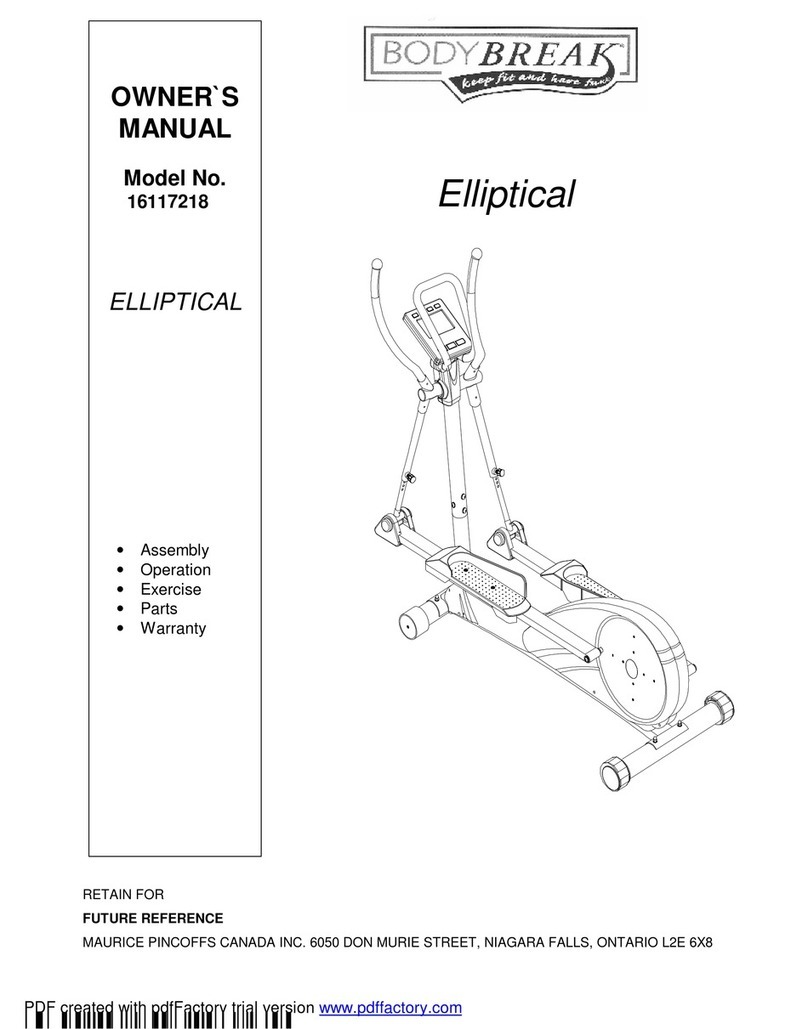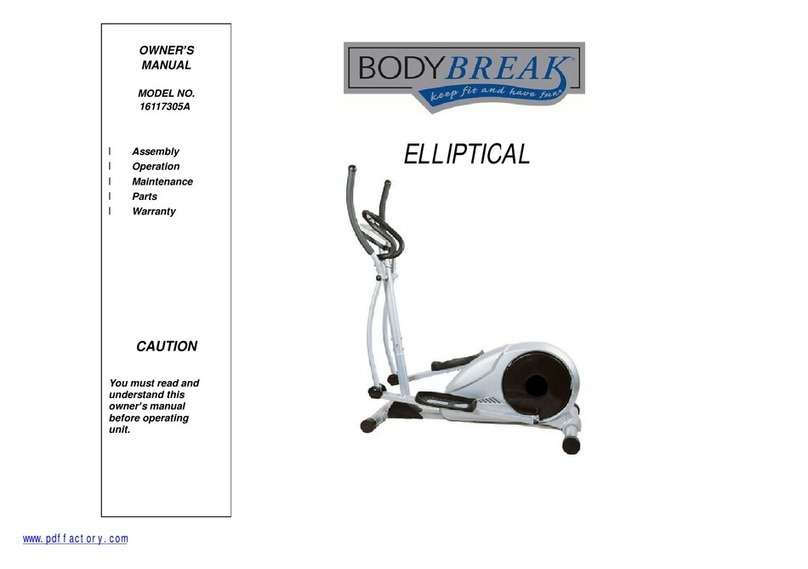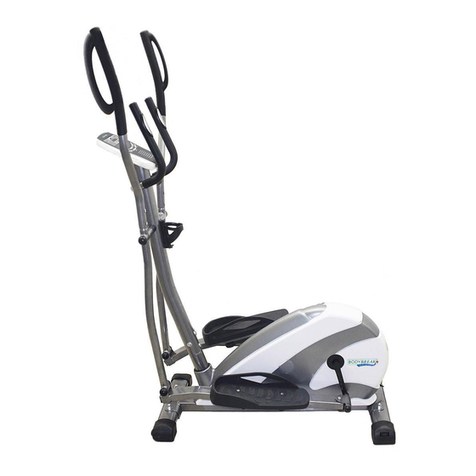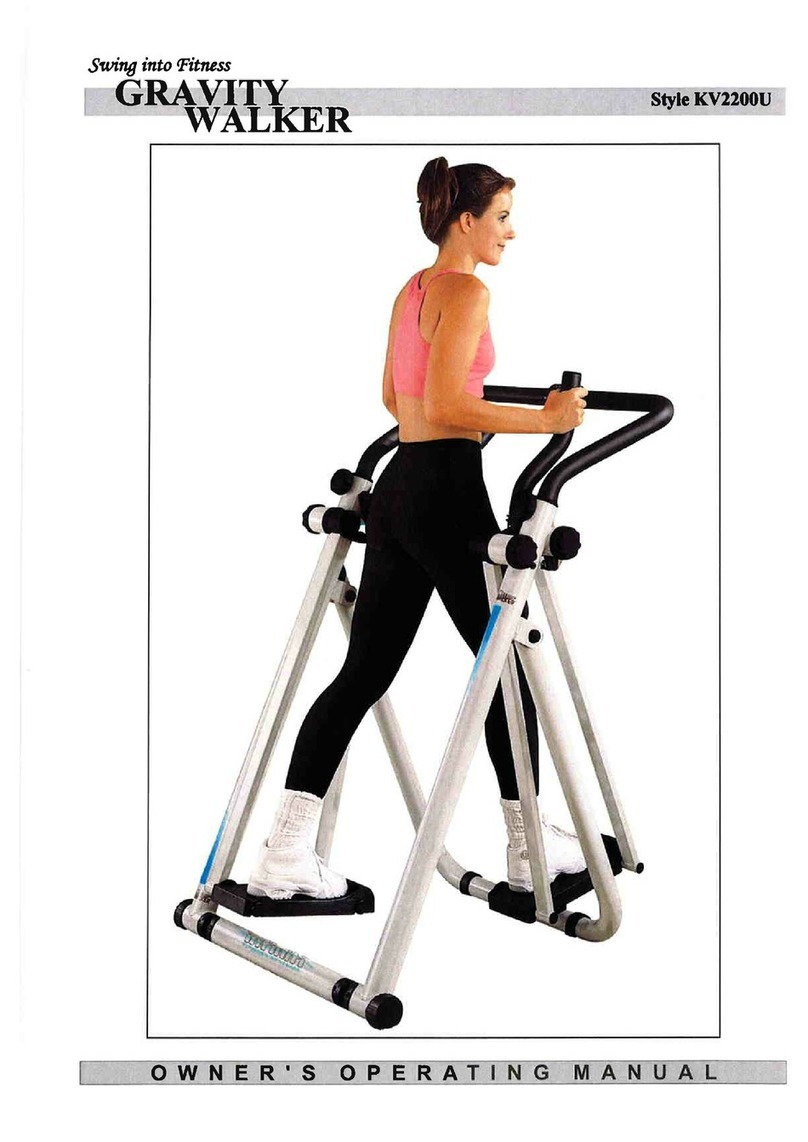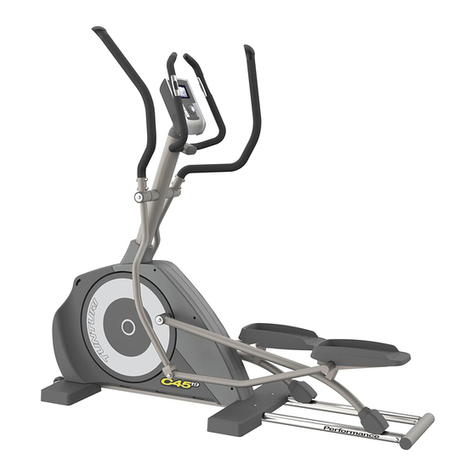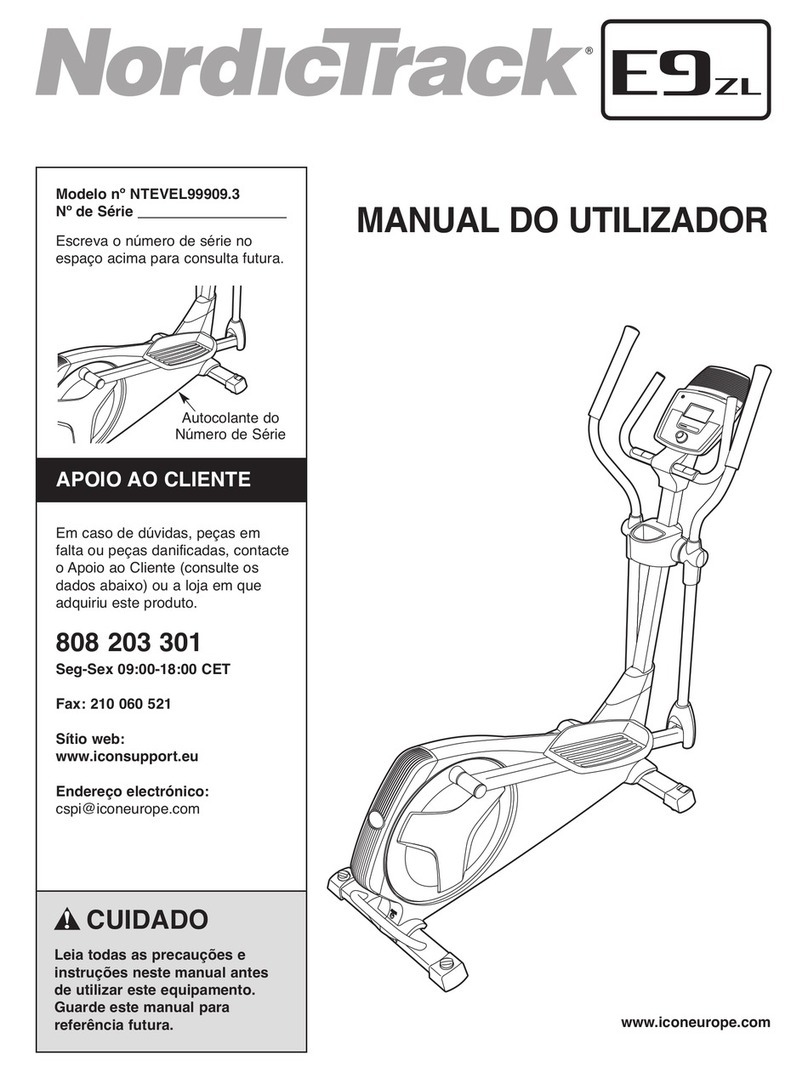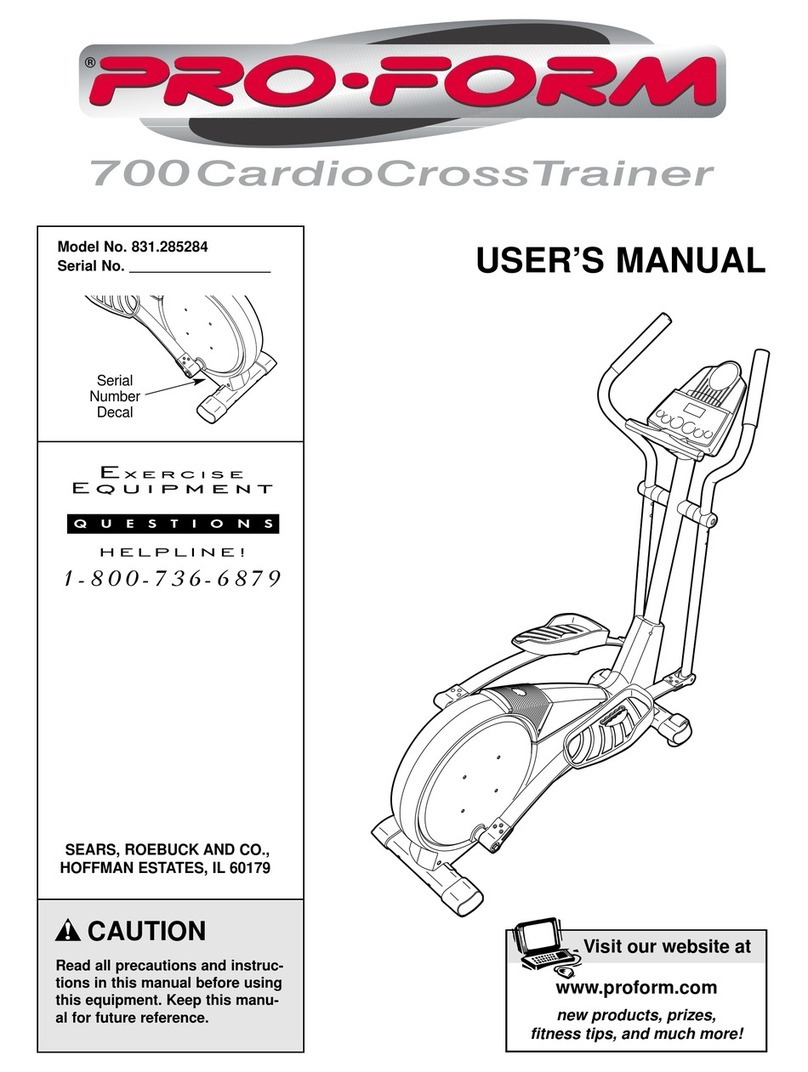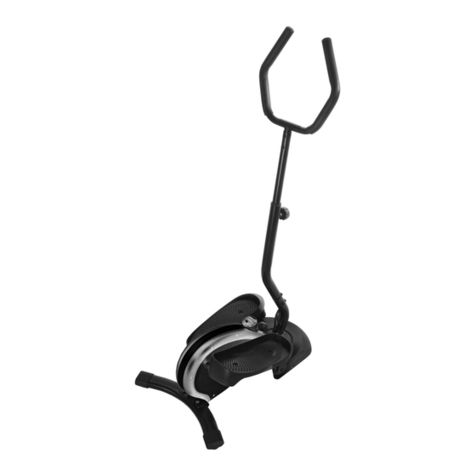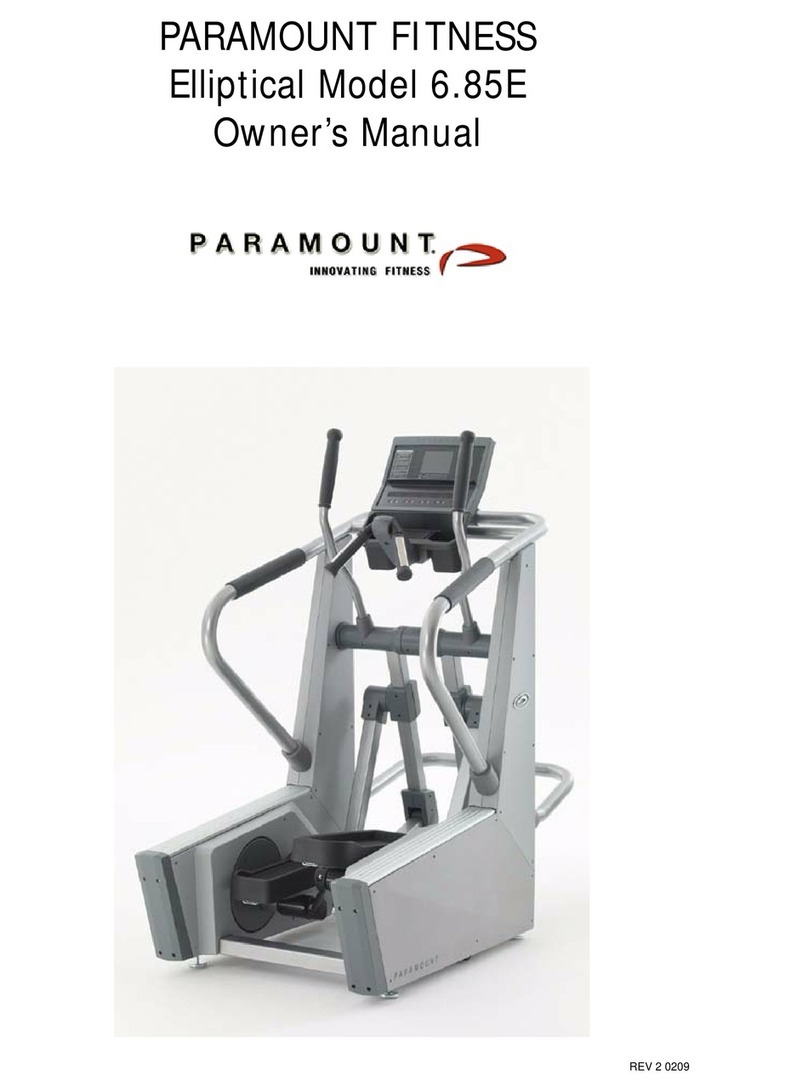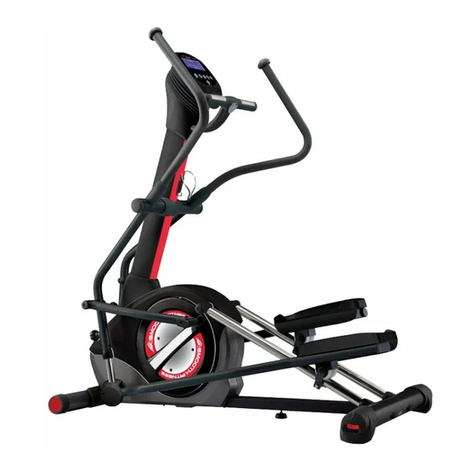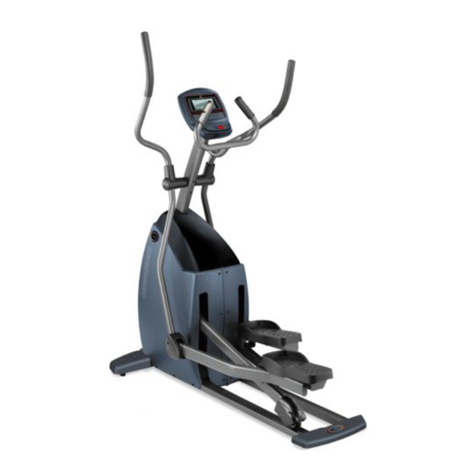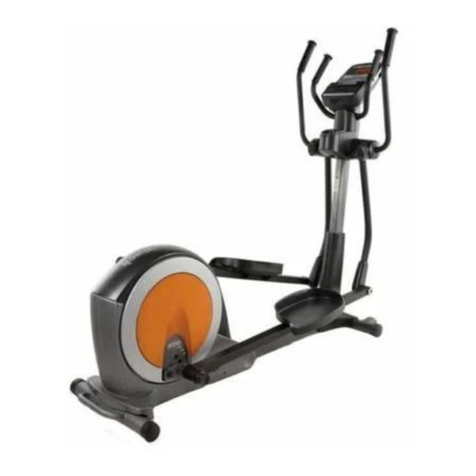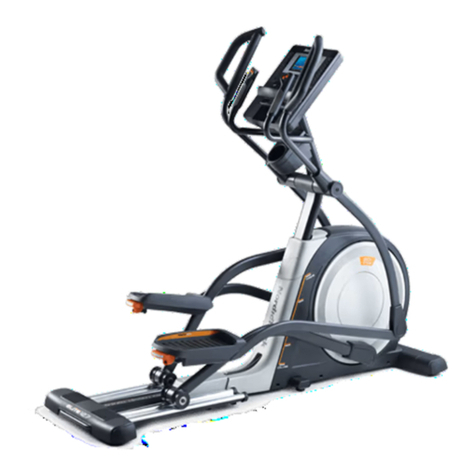Body Break 16117103 User manual

Front Drive Elliptical
RETAIN FOR FUTURE REFERENCE
MAURICE PINCOFFS CANADA INC. 6050 DON MURIE STREET, NIAGARA FALLS, ONTARIO L2E 6X8
OWNER`S
MANUAL
Model No.
16117103
•Assembly
•Operation
•Exercise
•Parts
•Warranty
CAUTION:
You must read and
understand this
owner’s manual
before operating
unit.

Customer Service 1-888-707-1880 2 Maurice Pincoffs Canada Inc.©2010
Manufacture’s One-Year Limited Warranty
Your Body Break Magnetic Elliptical is warranted for one year from the date of purchase
against defects in material when used for the purpose intended, under normal conditions and
provided it receives proper care. Any part found defective or missing will be sent at no cost
when returned in accordance with the terms of this warranty.
This warranty is not transferable and is extended only to the original owner.
The warranty shall not apply to exercise units which are (1) used for commercial or other
income producing purposes, or (2) subject to misuse, neglect, accident or unauthorized repair
and alterations.
This warranty provided herein is lieu of all other express warranties, any implied warranties,
including any implied warranties of merchantability of fitness for particular purpose, are limited in
duration to the first 12 months from date of purchase. All other obligations or liabilities, including
liability for consequential damages are hereby excluded.
REPAIR PARTS AND SERVICE
All of the parts for the elliptical shown in figure can be ordered from Maurice Pincoffs Canada
Inc. 6050 DON MURIE STREET, NIAGARA FALLS, ONTARIO L2E 6X8. When ordering parts,
the parts will be sent and billed at the current prices. Prices may be subject to change without
notice. Check or money order must accompany all orders. Standard hardware items are
available at your local hardware store.
To ensure prompt and correct handling of any errors, or to answer any questions, please call
our Toll Free number: 1-888-707-1880, or local number 1-905-353-8955 or fax 1-905-353-8968
Friday Eastern Standard Time.
Always include the following information when ordering parts
zModel number
zName of each part
zPart number of each part
TABLE OF CONTENTS
WARRANTY 2 DIAGRAM 12-13
SAFETY PRECAUTIONS 3 COMPUTER INSTRUCTION 14-15
PRE-ASSEMBLY CHECK LIST 4 TROUBLE SHOOTING 16
HARDWARE PACKING LIST 5 TRAINING GUIDELINES 17-19
ASSEMBLY INSTRUCTION 6-8 EXERCISE 20-21
PARTS LIST 9-11

Customer Service 1-888-707-1880 3 Maurice Pincoffs Canada Inc.©2010
SAFETY PRECAUTIONS
Thank you for purchasing our product. Even though we go to great efforts to ensure the quality
of each product we produce, occasional errors and/or omissions do occur. In any event should
you find this product to have either a defective or a missing part please contact us for a
replacement.
This product has been designed for home use only. Product liability and guarantee conditions
will not be applicable to products being subjected to professional use or products being used in
a gym centre.
This exercise equipment was designed and built for optimum safety. However, certain
precautions apply whenever you operate a piece of exercise equipment. Be sure to read the
entire manual before assembly and operation of this machine. Also, please note the following
safety precautions:
1. Read the OWNER’S OPERATING MANUAL and all accompanying literature and follow it
carefully before using your elliptical.
2. If dizziness, nausea, chest pains, or any other abnormal symptoms are experienced while
using this equipment, STOP the workout at once. CONSULT A PHYSICIAN
IMMEDIATELY.
3. Inspect your exercise equipment prior to exercising to ensure that all nuts and bolts are
fully tightened before each use.
4. The elliptical must be regularly checked for signs of wear and damage. Any part found
defective, the part must be replaced with new spare part from the manufacturer.
5. Fitness equipment must always be installed on a flat surface, do not place the unit on a
loose rug or uneven surface. It is recommended to use an equipment mat to prevent the
unit from moving while it is being used, which could possibly scratch or damage the
surface of your floor.
6. No changes must be made which might compromise the safety of the equipment.
7. It is recommended to have a minimum of 2’ safe clearance around the exercise
equipment while in use.
8. Keep children and pets away from this equipment at all times while exercising.
9. Warm up 5 to 10 minutes before each workout and cool down 5 to 10 minutes afterward.
This allows your heart rate to gradually increase and decrease and will help prevent you
from straining muscles.
10. Never hold your breath while exercising. Breathing should remain at a normal rate in
conjunction with the level of exercise being performed
11. Always wear suitable clothing and footwear while exercising. Do not wear loose fitting
clothing that could become entangled with the moving parts of your elliptical.
12. Care must be taken when lifting or moving the equipment, so as not to injure your back.
Always use proper lifting techniques
13. User weight should not exceed 265 lbs.
WARNING: Before beginning any exercise program consult your physician. This is
especially important for individuals over the age of 35 or persons with pre-existing
health problems. Read all instructions before using any fitness equipment. We
assume no responsibility form personal injury or property damage sustained by or
through the use of this product.

Customer Service 1-888-707-1880 4 Maurice Pincoffs Canada Inc.©2010
PRE-ASSEMBLY CHECK LIST
PART NO. DESCRIPTION Q’TY
1 Main frame 1
2 Rear Stabilizer assembly 1
4 Front Stabilizer 1
10 Axle 1
9 Upright 1
13 Bottom handlebar L/R 2
27/28 Handlebar cover front and rear 2
29 Stationary handlebar 1
30 Computer 1
42 Foot pedal arm L/R 2
43 Top handlebar L/R 2
44 Foot pedal tube L/R 2
46 Pedal L/R 2
Inner Box 1
Manual 1

Customer Service 1-888-707-1880 5 Maurice Pincoffs Canada Inc.©2010
HARDWARE PACKING LIST
Above described parts are all the parts you need to assemble this machine. Before you
start to assemble, please check the hardware packing to make sure they are included.
Part NO Description Q’ty Drawings
6 Carriage bolt M8*60 4
7 Curve washer Φ20*Φ8 10
6 7
8 Domed nut M8 4
14 PVC cap 4
8 14
19 Hex head bolt M10*65 2
20 Sleeve 2 19 20
21 Nylon locknut M10 2
22 Flat washer Φ22*Φ10 2
21 22
25 Carriage bolt Φ8*20 4
26 Allen screw M6*12 4 25 26
34 Allen screw M8*10 8
35 Allen bolt M8*50 2 34 35
36 Allen screw M8*20 6
38 Flat washer Φ8*Φ25 8
36 38
48 Nylon locknut M8 2
51 Spring washer Φ8 2
48 51
56 Hex head screw M8*20 2
89 Allen Key L4 1 56 89
90 Allen Wrench S17*S13 2
91 Allen Key L6 1 90 91
92 Allen Key L5 1
5mm
92

Customer Service 1-888-707-1880 6 Maurice Pincoffs Canada Inc.©2010
ASSEMBLY INSTRUCTION
This manual is designed to help you easily assemble, adjust and use this machine. Please read
this manual carefully. For the sake of familiarizing yourself with the parts identified in the
instruction, first study the overview drawing.
Set all parts in a clear area on the floor and remove the packing material. Refer to the parts list
for help to identify the parts.
It will take two people to assemble your unit.
ENSURE THAT ALL NUTS AND BOLTS ARE FIRMLY TIGHTENED AFTER EACH STEP
STEP 1
1. Attach the front stabilizer (4) to the main frame (1). Secure using two carriage bolts (6), two
curve washers (7) and two domed nuts (8).
2. Attach the rear stabilizer assembly (2) to the main frame (1). Secure using two carriage bolts
(6), two curve washers (7) and two domed nuts (8).
STEP 2
1. Attach the left Pedal (46L) to the left foot pedal arm (42L). Secure with two allen screws
(36).
2. Attach the left foot pedal tube (44L) to the left crank arm (60L). Secure using one hex head
screw (56), one spring washer (51) and one flat washer (38).
3. Attach the left foot pedal arm (42L) to the left foot pedal tube (44L). Secure using one allen
bolt (35), one flat washer (38) and one nylon locknut (48).
4. Repeat for the right side.

Customer Service 1-888-707-1880 7 Maurice Pincoffs Canada Inc.©2010
STEP 3
1. Connect the extension sensor wire (54) to the sensor wire (52).
2. Turn the tension control knob (11) to level 8. Insert the end of the tension cable (11) to the
bracket of the lower tension control cable (53). See inset. Note: it is necessary to insert
the cable into the main frame once attached.
3. Attach the upright (9) to the main frame (1). Secure using eight allen screws (34), four
curved washers (7) and four flat washers (38).
4. Insert the axle (10) through the upright (9). Attach the left bottom handlebar (13L) to the
left side of the axle (10). Secure with one D type washer (18), one flat washer (17), one
spring washer (16) and one hex head screw (15) which are pre-assembled on the axle.
5. Attach the left foot pedal arm (42L) to the left bottom handlebar (13L). Secure using one
hex head bolt (19), one sleeve (20), one flat washer (22), one nylon locknut (21) and two
PVC caps (14).
6. Repeat for the right bottom handlebar (13R).

Customer Service 1-888-707-1880 8 Maurice Pincoffs Canada Inc.©2010
STEP 4
1. Attach the left top handlebar (43L) to the left Bottom handlebar (13L). Secure using two
carriage bolts (25) and two allen bolts (26).
2. Repeat for the right side .
STEP 5
1. Attach the stationary handlebar w/handpulse (29) to the bracket of the upright (9). Secure
using two allen screws (36) and two curve washers (7).
2. Insert the handpulse wire (85) through the grommet (55) and through the hole in the upright
(9). Pull it through the hole at the top of the upright (9) and insert the grommet (55) into the
upright. Connect the handpulse wire (85) to the back of the computer (30).
3. Connect the extension sensor wire (54) to the back of the computer (30).
4. Slide the computer (30) on to the bracket of the upright (9). Secure the computer (30)
using two screws (33) which are pre-assembled on the back of computer.
Note: Ensure that the wires are away from the bracket when sliding on the computer.
5. Remove the screws (24) from the front and rear handlebar covers (28 & 27). Attach the
front and rear covers (28 / 27) to the left side of the axle where the top and bottom left
handlebar join. Secure using the two screws (24). Repeat for the right side.
27
YOUR UNIT IS NOW FULLY ASSEMBLED

Customer Service 1-888-707-1880 9 Maurice Pincoffs Canada Inc.©2010
PARTS LIST
No. Part No. Description Qty
1 1710301 Main frame 1
2 1710302 Rear stabilizer assembly 1
3 1710303 Leveling cap 2
4 1710304 Front stabilizer 1
5 1710305 Transportation wheel 2
6 1710306 Carriage bolt M8*60 4
7 1710307 Curve washer Φ20*Φ8 10
8 1710308 Domed nut M8 4
9 1710309 Upright 1
10 1710310 Axle 1
11 1710311 Tension control w/cable 1
12 1710312 Bushing 6
13L 1710313L Bottom handlebar left 1
13R 1710313R Bottom handlebar right 1
14 1710314 PVC cap 4
15 1710315 Hex head screw M10*20 2
16 1710316 Spring washer Φ10 2
17 1710317 Flat washer Φ32*Φ10 2
18 1710318 D type washer 2
19 1710319 Hex head bolt M10*65 2
20 1710320 Sleeve 2
21 1710321 Nylon locknut M10 2
22 1710322 Flat washer Φ22*Φ10 4
23 1710323 Bushing 4
24 1710324 Self-tapping screw 4
25 1710325 Carriage bolt Φ8*20 4
26 1710326 Allen screw M6*12 4
27 1710327 Rear handlebar cover 2
28 1710328 Front handlebar cover 2
29 1710329 Stationary handlebar 1
30 1710330 Computer 1
31 1710331 End cap 2
32 1710332 Round end cap Φ25.4 2

Customer Service 1-888-707-1880 10 Maurice Pincoffs Canada Inc.©2010
PARTS LIST
No. Part No. Description Qty
33 1710333 Screw M5*10 2
34 1710334 Allen screw M8*10 8
35 1710335 Allen bolt M8*50 2
36 1710336 Allen screw M8*20 6
37 1710337 Hand pulse sensor 2
38 1710338 Flat washer Φ8*Φ25 8
39 1710339 U type bracket 2
40 1710340 Allen bolt M8*45 4
41 1710341 Flat washer Φ8*Φ17 2
42L 1710342L Foot pedal arm left 1
42R 1710342R Foot pedal arm right 1
43L 1710343L Top handlebar left 1
43R 1710343R Top handlebar right 1
44L 1710344L Foot pedal tube left 1
44R 1710344R Foot pedal tube right 1
45 1710345 Adjustable knob 2
46L 1710346L Pedal left 1
46R 1710346R Pedal right 1
47 1710347 Cap for crank 2
48 1710348 Nylon locknut M8 7
49 1710349 Square end cap 2
50 1710350 Bushing for pedal tube 4
51 1710351 Spring washer Φ8 2
52 1710352 Sensor wire 1
53 1710353 Lower tension control cable 1
54 1710354 Extension sensor wire 1
55 1710355 grommet 1
56 1710356 Hex head screw M8*20 2
57 1710357 Wheel 2
59 1710359 France nut 4
60L 1710360L Left crank 1
60R 1710360R Right crank 1

Customer Service 1-888-707-1880 11 Maurice Pincoffs Canada Inc.©2010
PARTS LIST
No. Part No. Description Qty
61 1710361 Crank axle 1
62 1710362 Allen bolt M6*15 4
63 1710363 Nylon locknut M6 4
64 1710364 Sensor bracket 1
65 1710365 Screw ST5*15 8
66 1710366 Bearing 2
67 1710367 Magnet assembly 1
68 1710368 Spacer 2
69 1710369 Allen bolt M8*55 1
70 1710370 Spring 1
71 1710371 Nut M6 2
72 1710372 Hex head bolt M6*25 1
73 1710373 Screw ST5*15 4
74L 1710374L Chain cover left 1
74R 1710374R Chain cover right 1
75 1710375 Cap for chain cover 2
76 1710376 Flywheel 1
77 1710377 Adjustor 2
78 1710378 Belt-drive wheel 1
79 1710379 C clip 2
80 1710380 Inner cap 1
81 1710381 Belt 1
82 1710382 Flat washer Φ12*Φ4.2 2
83 1710383 Screw ST4*15 2
84 1710384 Bearing 4
85 1710385 Hand pulse wire 2
86 1710386 Foam grip for stationary handlebar 2
87 1710387 Foam grip for top handlebar 2
88 1710388 Spacer 2
89 1710389 Allen key L4 1
90 1710390 Allen key S17*S13 2
91 1710391 Allen key L6 1
92 1710392 Allen key L5 1

Customer Service 1-888-707-1880 12 Maurice Pincoffs Canada Inc.©2010
DIAGRAM

Customer Service 1-888-707-1880 13 Maurice Pincoffs Canada Inc.©2010

Customer Service 1-888-707-1880 14 Maurice Pincoffs Canada Inc.©2010
MONITOR INSTRUCTION
FUNCTION BUTTONS
MODE: Press to select functions between: scan, time, calories, odometer, pulse speed
and distance.
SET: Press to preset the target value of time, distance and calorie.
RESET: Press to reset your preset value to zero.
Press and hold for 2 seconds to reset except for Odometer.
(All the values will reset to ZERO automatically when change the batteries.)
Function:
Scan: Displays each function in sequence every 6 seconds. The display loop is
Time – Speed – Distance – Odometer – Calories – Pulse.
Time: Shows your elapsed workout time up to 99:59
Counts down from your preset target time to 00:00 during your workout
Calorie: Displays the cumulative calories burned at any given time during your workout up
to 999 cal.
Counts down from your preset target calorie to 0 cal.
Note: This is a rough guide used for comparison of different exercise sessions,
which cannot be used for medical purposes.
Odometer Displays the total distance accumulated up to 99.59 miles.
Gripped pulse: The monitor will display the user’s current heart rate in beats per minute during
the workout. Both hands must hold the gripped pulse for a heart rate reading
during your workout.
Speed: Displays the current speed up to 99.9 mph.
Distance: Displays the cumulative distance traveled during your workout up to 99.9 miles
Counts down from your preset target time to 0.0 during your workout

Customer Service 1-888-707-1880 15 Maurice Pincoffs Canada Inc.©2010
Monitor Function:
How to preset time, distance, calories and pulse
1. Press the mode button until desired function is displayed.
2. Press the set until your desired number is displayed.
3. Press the mode button to accept value
The monitor will count down from your preset value once you start exercising.
The monitor will beep to indicate the completion of your preset value. Press any button to stop
the beep and the monitor will now start to count up.
If more than one value is preset, the first to reach the value will sound the alarm. Once you
have stopped the alarm the next preset value will sound the alarm until you have reached all
preset values.
Remarks
1. Monitor requires two “AA” batteries
2. The monitor will turn on automatically by pressing any key or when you start pedaling.
3. The monitor will turn off automatically if no signal is detected for four minutes.
4. If monitor is illegible or partial segments appear, remove batteries and wait 15
seconds to re-install.
5. Removing the batteries will reset all values to zero.

Customer Service 1-888-707-1880 16 Maurice Pincoffs Canada Inc.©2010
TROUBLE SHOOTING
Problem Cause Correction
Monitor does not
display Batteries weak or dead Replace batteries
Sending unit not connected
Securely plug sending unit into
extension wire and the back of the
monitor
Sending unit not working
properly Replace sending unit
No speed or distance
displays on the monitor
Monitor not working
properly Replace monitor
Tension control cable not
connected
Securely plug tension control
cable into the extension tension
control cable
No tension
Magnetic wheel not
working properly Replace magnetic wheel
Pulse wire not connected
not connected
Securely plug wires into the back
of the monitor
Hand pulse defective Replace hand pulse grip or ear clip
Heart rate not
displaying
Monitor not working
properly Replace monitor
Crank bearing defective Replace crank bearings
Idler pulley defective Replace idler pulley
Grinding
Mag wheel defective Replace magnetic wheel
Squealing V-belt slipping Adjust v-belt
Always ensure batteries are fresh and in correctly.

Customer Service 1-888-707-1880 17 Maurice Pincoffs Canada Inc.©2010
TRAINING GUIDELINES
Exercise
Exercise is one of the most important factors in the overall health of an individual. Listed among
its benefits are:
xIncreased capacity for physical work (strength endurance)
xIncreased cardiovascular (heart and arteries/veins) and respiratory efficiency
xDecreased risk of coronary heart disease
xChanges in body metabolism, e.g. losing weight
xDelaying the physiological effects of age
xPhysiological effects, e.g. reduction in stress, increase in self-confidence, etc.
Basic Components of Physical Fitness
There are four all encompassing components of physical fitness and we need to
briefly define each and clarify its role.
Strength is the capacity of a muscle to exert a force against resistance. Strength
contributes to power and speed and is of great importance to a majority of sports people.
Muscular Endurance is the capacity to exert a force repeatedly over a period of time, e.g.
it is the capacity of your legs to carry you 10 Km without stopping.
Flexibility is the range of motion about a joint. Improving flexibility involves the stretching of
muscles and tendons to maintain or increase suppleness, and provides increased
resistance to muscle injury or soreness.
Cardio-Respiratory Endurance is the most essential component of physical fitness. It is the
efficient functioning of the heart and lungs
Aerobic Fitness
The largest amount of oxygen that you can use per minute during exercise is called your
maximum oxygen uptake (MVo2). This is often referred to as your aerobic capacity.
The effort that you can exert over a prolonged period of time is limited by your ability to deliver
oxygen to the working muscles. Regular vigorous exercise produces a training effect that can
increase your aerobic capacity by as much as 20 to 30%. An increased MVO2 indicates an
increased ability of the heart to pump blood, of the lungs to ventilate oxygen and of the muscles
to take up oxygen.
Anaerobic Training
This means “without oxygen” and is the output of energy when the oxygen supply is insufficient
to meet the body’s long term energy demands. (For example, 100 meter sprint).
The Training Threshold
This is the minimum level of exercise which is required to produce significant improvements in
any physical fitness parameter.
Progression
As your become fitter, a higher intensity of exercise is required to create an overload and
therefore provide continued improvement
Overload
This is where you exercise at a level above that which can be carried out comfortably. The
intensity, duration and frequency of exercise should be above the training threshold and should
be gradually increased as the body adapts to the increasing demands. As your fitness level
improves, so the training threshold should be raised.
Working through your program and gradually increasing the overload factor is important.

Customer Service 1-888-707-1880 18 Maurice Pincoffs Canada Inc.©2010
Specificity
Different forms of exercise produce different results. The type of exercise that is carried out is
specific both to the muscle groups being used and to the energy source involved.
There is little transfer of the effects of exercise, i.e. from strength training to cardiovascular
fitness. That is why it is important to have an exercise program tailored to your specific needs.
Reversibility
If you stop exercising or do not do your program often enough, you will lose the benefits you
have gained. Regular workouts are the key to success.
Warm Up
Every exercise program should start with a warm up where the body is prepared for the effort to
come. It should be gentle and preferably use the muscles to be involved later.
Stretching should be included in both your warm up and cool down, and should be performed
after 3-5 minutes of low intensity aerobic activity or callisthenic type exercise.
Warm Down or Cool Down
This involves a gradual decrease in the intensity of the exercise session. Following exercise, a
large supply of blood remains in the working muscles. If it is not returned promptly o the central
circulation, pooling of blood may occur in the muscles
Heart Rate
As you exercise, so the rate at which your heart beat also increases. This is often used as a
measure of the required intensity of exercise. You need to exercise hard enough to condition
your circulatory system, and increase your pulse rate, but not enough to strain your heart.
Your initial level of fitness is important in developing an exercise program for you. If you are
starting off, you can get a good training effect with a heart rate of 110-120 beats per
minute(BPM). If you are fitter, you will need a higher threshold of stimulation.
To begin with, you should exercise at a level that elevates your heart rate to about 65 to 70% of
your maximum. If you find this is too easy, you may want to increase it, but it is better to lean on
the conservative side.
As a rule of thumb, the maximum heart rate is 220 minus your age. As you increase in age, so
your heart, like other muscles, loses some of its efficiency. Some of its natural loss is won back
as fitness improves.
The following table is a guide to those who are “starting fitness”.
Age 25 30 35 40 45 50 55 60 65
Target heart Rate
10 Second Count 23 22 22 21 20 19 19 18 18
Beats per Minute 138 132 132 126 120 114 114 108 108
Pulse Count
The pulse count(on your wrist or carotid artery in the neck, taken with two index fingers)is done
for ten seconds, taken a few seconds after you stop exercising. This is for two reasons: (a) 10
seconds is long enough for accuracy, (b) the pulse count is to approximate your BPM rate at the
time you are exercising. Since heart rate slows as you recover, a longer count isn’t as accurate.
The target is not a magic number, but a general guide. If you’re above average fitness, you may
work quite comfortably a little above that suggested for your age group.
The following table is a guide to those who are keeping fit. Here we are working at about 80% of
maximum.
Age 25 30 35 40 45 50 55 60 65
Target heart Rate
10 Second Count 26 26 25 24 23 22 22 21 20
Beats per Minute 156 156 150 144 138 132 132 126 120

Customer Service 1-888-707-1880 19 Maurice Pincoffs Canada Inc.©2010
Don’t push yourself too hard to reach the figures on this table. It can be very uncomfortable if
you overdo it. Let it happen naturally as you work through your program. Remember, the target
is a guide, not a rule, a little above or below is just fine.
Two final comments:(1) don’t be concerned with day to day variations in your pulse rate, being
under pressure or not enough sleep can affect it;(2) your pulse rate is a guide, don’t become a
slave to it.
Endurance Circuit Training
Cardiovascular endurance, muscle, strength, flexibility and coordination are all necessary for
maximum fitness. The principle behind circuit training is to give a person all the essentials at
one time by going through your exercise program moving as fast as possible between each
exercise. This increases the heart rate and sustains it, which improves the fitness level. Do not
introduce this circuit training effect until you have reached an advanced program stage.
Body Building
Is often used synonymously with strength training The fundamental principal here is
OVERLOAD. Here, the muscle works against greater loads than usual. This can be done by
increasing the load you are working against.
Patronization
This is the term used to vary your exercise program for both physiological and psychological
benefits. In your overall program, you should vary the workload, frequency and intensity. The
body responds better to variety and so do you. In addition, when you feel yourself getting “stale’,
bring in periods of lighter exercise to allow the body to recuperate and restore its reserves. You
will enjoy your program more and feel better for it.
Muscle Soreness
For the first week or so, this may be the only indication you have that you are on an exercise
program. This, of course, does depend on your overall fitness level. A confirmation that you are
on the correct program is a very slight soreness in most major muscle groups. This is quite
normal and will disappear in a matter of days.
If you experience major discomfort, you may be on a program that is too advanced or you have
increased your program too rapidly.
If you experience PAIN during or after exercise, your body is telling your something.
Stop exercising and consult your doctor.
What to Wear
Wear clothing that will not restrict your movement in any way while exercising. Clothes should
be light enough to allow the body to cool. Excessive clothing that causes you to perspire more
than you normally would while exercising, gives you no advantage. The extra weight you lose is
body fluid and will be replaced with the next glass of water you drink. It is advisable to wear a
pair of gym or running shoes or “sneakers”.
Breathing during Exercise
Do not hold your breath while exercising. Breathe normally as much as possible. Remember,
breathing involves the intake and distribution of oxygen, which feeds the working muscles.
Rest periods
Once you start your exercise program, you should continue through to the end. Do not break off
halfway through and then restart at the same place later on without going through the warm-up
stage again.
The rest period required between strength training exercises may vary from person to person.
This will depend mostly on your level of fitness and the program you have chosen. Rest
between exercises by all means, but do not allow this to exceed two minutes. Most people
manage with half minute to one minute rest periods

Customer Service 1-888-707-1880 20 Maurice Pincoffs Canada Inc.©2010
STRETCHING
Stretching should be included in both your warm up and cool down, and should be performed
after 3-5 minutes of low intensity aerobic activity or callisthenic type exercise. Movements
should be performed slowly and smoothly, with no bouncing or jerking. Move into the stretch
until slight tension, not pain, is felt in the muscle and hold for 20-30 seconds. Breathing should
be slow, rhythmical and under control, making sure never to hold your breath.
HEAD ROLLS SHOULDER LIFTS
Rotate your head to the right for one count, feeling Lift your right shoulder up toward your ear
the stretch up the left side of your neck. Next rotate for one count. Then lift your left shoulder
your head back for one count, stretching your chin to up for one count as you lower your right
the ceiling and letting your mouth open. Rotate your shoulder.
head to the left for one count, and finally, drop your
head to your chest for one count.
SIDE STRETCHES QUADRICEPS STRETCH
Open your arms to the side and continue lifting With one hand against a wall for balance,
them until they are over your head. Reach your reach behind you and pull your right foot up.
right arm as far upward toward the ceiling as Bring your heel as close to your buttocks as
you can for one count. Feel the stretch up possible. Hold for 15 counts and repeat with
your right side. Repeat this action with your left foot up.
left arm.
Table of contents
Other Body Break Elliptical Trainer manuals
Popular Elliptical Trainer manuals by other brands

NordicTrack
NordicTrack E7 Rear Drive Elliptical Manual Del Usuario
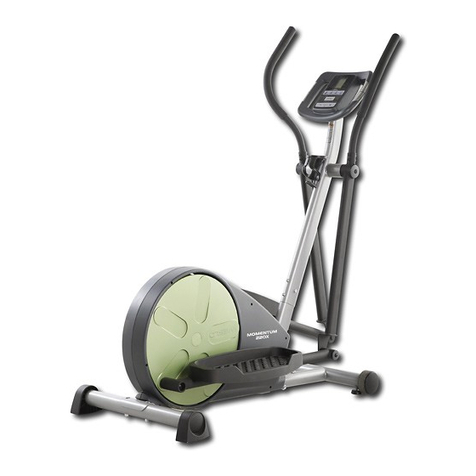
Weslo
Weslo Momentum 220X WLEL2006.0 user manual

Daum electronic
Daum electronic ergo_lyps user manual
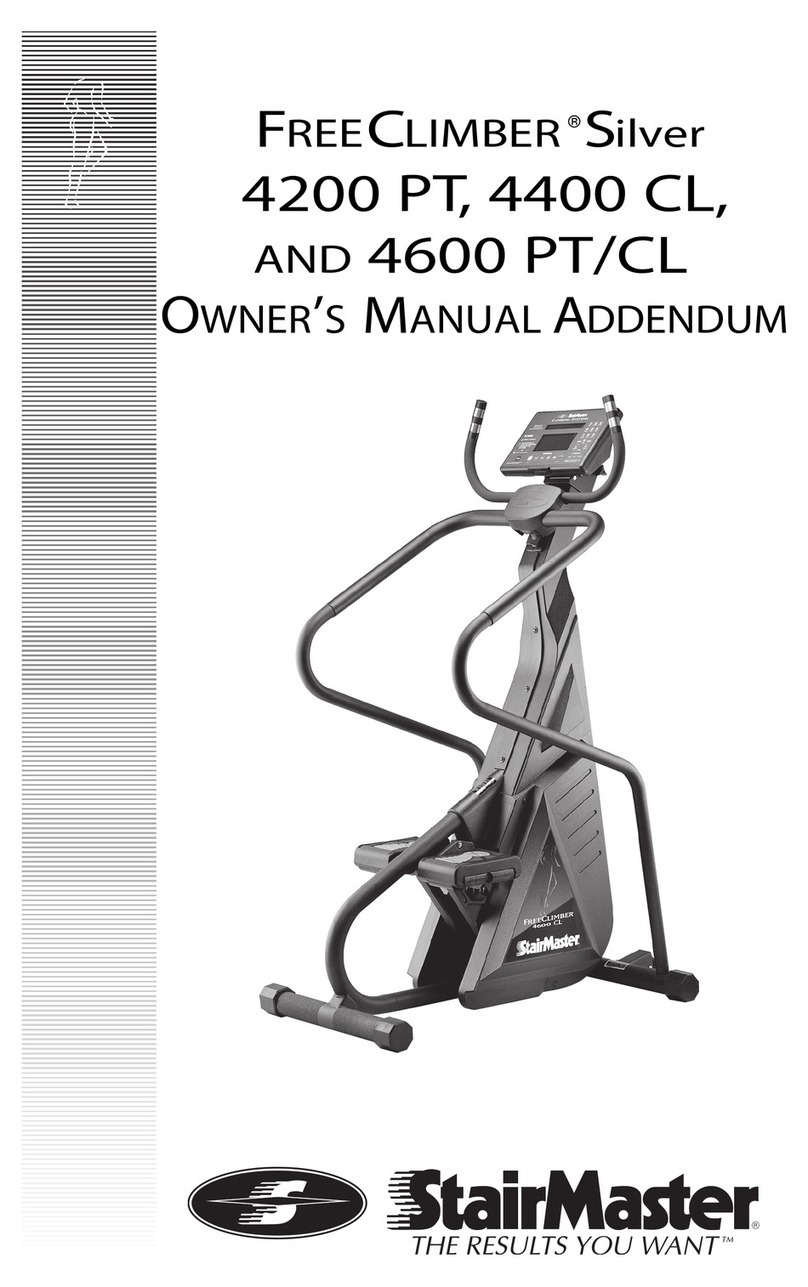
Stairmaster
Stairmaster FREEC LIMBER Silver 4200 PT Owner's manual addendum

Insportline
Insportline inCondi ET660i II user manual
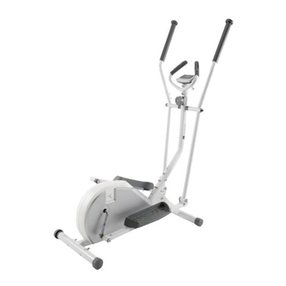
Domyos
Domyos VE 200 user manual
